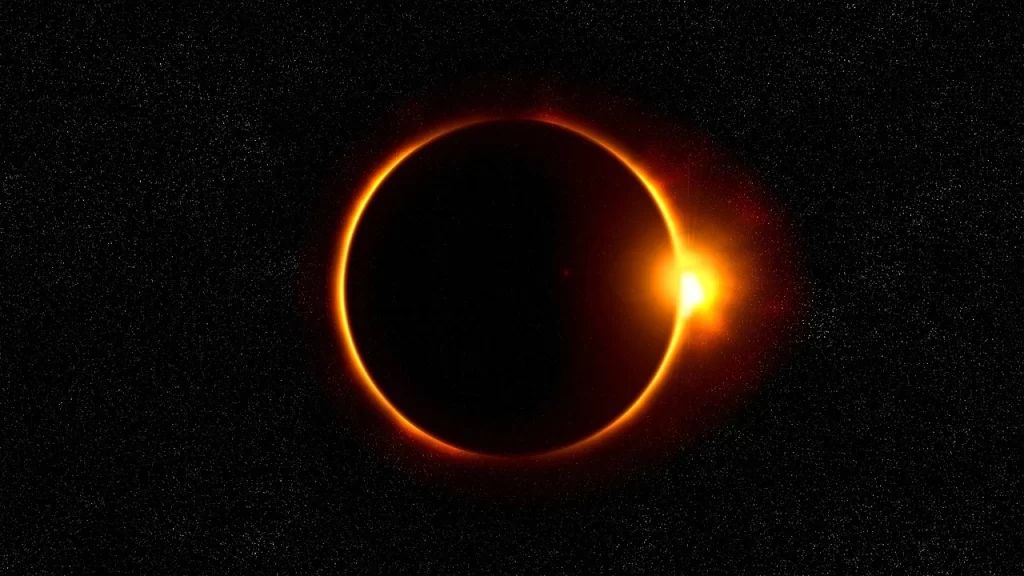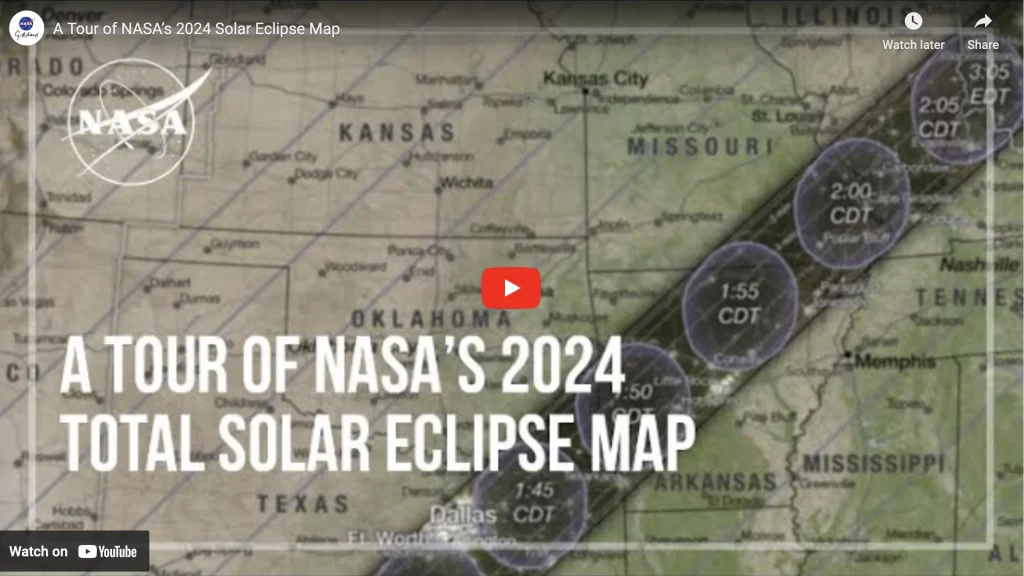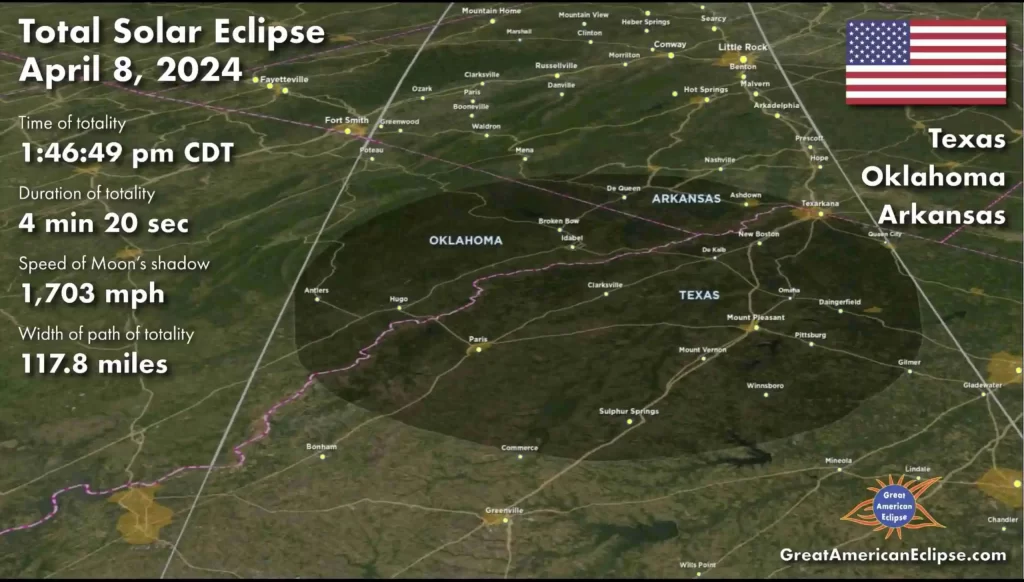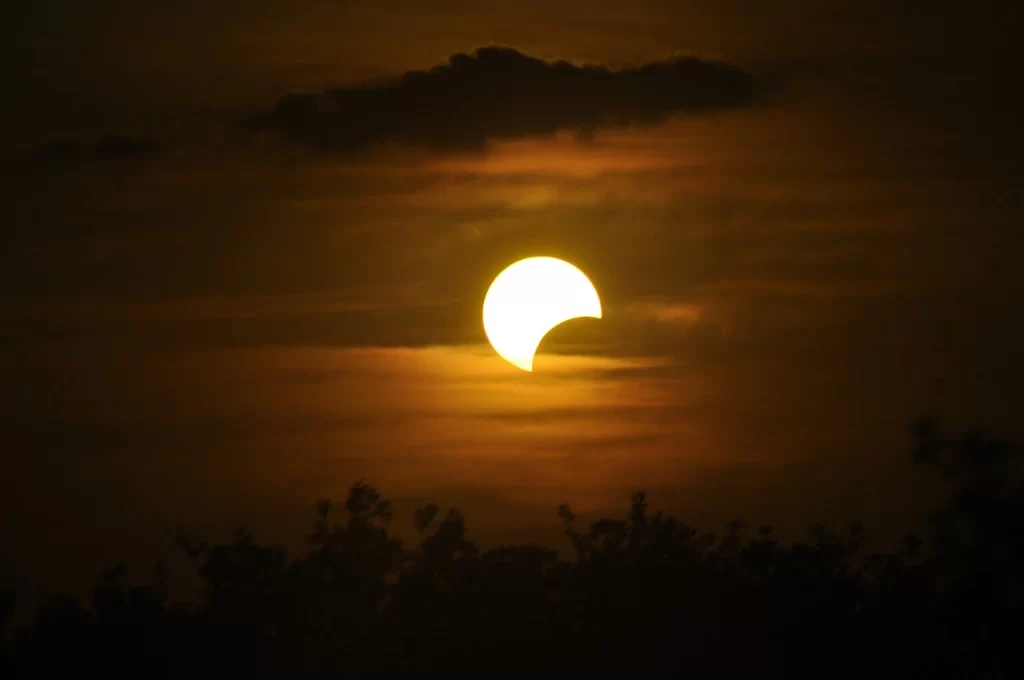As the celestial event of a lifetime approaches, stargazers and adventure seekers alike are gearing up for the upcoming 2024 solar eclipse set to sweep across the United States. Oklahoma is poised to be a prime viewing location, with a special invitation for visitors to explore the charming city of Chickasha.
The 2024 solar eclipse is one you don’t want to miss. This will be the darkest solar eclipse in over 200 Years!
Adventure seekers coming to Oklahoma will not only enjoy this cosmic spectacle, but they also get a chance to explore the state’s heritage and attractions. This includes the hidden gems in Chickasha Oklahoma, like the iconic 50ft leg lamp, making it an ideal destination for an unforgettable experience.
Why You Should Anticipate the 2024 Total Solar Eclipse

The 2024 total solar eclipse is set to be an extraordinary celestial event that should not be missed. This eclipse will be visible in northern Mexico, the United States, and southeastern Canada. It promises to be a rare and unique experience for millions of people, offering a chance to witness totality and see the sun’s corona with the naked eye.
- The Longest U.S. Total Solar Eclipse since 1806
One of the most exciting aspects of the 2024 solar eclipse is its duration. Those lucky enough to witness totality may experience up to 4 minutes and 28 seconds of darkness. Even as the moon’s shadow moves across the U.S.-Mexico border, the duration of totality can still reach an impressive 4 minutes and 26 seconds. To put this into perspective, the last time North America witnessed such a long totality was on June 16, 1806. Known as Tecumseh’s Eclipse, this event lasted up to 4 minutes and 55 seconds and was visible from Baja California to Cape Cod. - Solar Maximum Synchronicity
The 2024 total solar eclipse is also significant because it coincides with solar maximum, a period of increased solar activity. During solar maximum, the sun’s corona appears larger, more symmetrical, and sunflower-like. This enhanced display of the corona makes the experience of witnessing totality even more spectacular. The last time North America witnessed a total solar eclipse during solar maximum was on February 26, 1979. By aligning the eclipse with solar maximum, viewers can anticipate an awe-inspiring sight that will leave a lasting impression. - The Darkest U.S. Total Solar Eclipse in 217 Years
A longer totality also means a darker totality, which adds to the intrigue of the upcoming solar eclipse. While the 2017 total solar eclipse offered a mesmerizing experience, the 2024 eclipse is expected to be even darker. The darkness during an eclipse is determined by its magnitude, which refers to the fraction of the sun’s diameter obscured by the moon. In 2017, the magnitude was 1.03, resulting in a path of totality approximately 70 miles wide. However, in 2024, the magnitude will be 1.05, with a path of totality spanning about 115 miles. This increase in darkness will reveal not only Venus but also Jupiter, making the eclipse even more captivating. - A Potential Comet Appearance
An added bonus is the possibility of observing a comet during totality. Comet 12P/Pons-Brooks, also known as the “Devil Comet,” will be approximately 25 degrees from the sun, relatively close to Jupiter. Although spotting the comet with the naked eye may be challenging, it could reach a magnitude of +4.7 and become visible. While the chances of seeing the comet are slim, it has been known to have outbursts in the past. During the 2020 total solar eclipse in Chile and Argentina, Comet C/2020 X3 (SOHO) was detected during totality. So, keep your binoculars handy and be on the lookout for this celestial phenomenon. - The Most-Watched Total Solar Eclipse in North America
With an estimated 31 million people residing within the path of totality in the United States alone, the 2024 total solar eclipse is set to become the most-watched eclipse in North American history. The path of totality will traverse parts of 15 U.S. states, northern Mexico, and Canada. Compared to the 2017 total solar eclipse, which attracted approximately 12 million viewers, the 2024 eclipse will capture the attention of a much larger audience. This widespread interest reflects the significance and excitement surrounding this celestial event. - An Urban Eclipse Experience
Unlike previous eclipses, the 2024 total solar eclipse will provide an opportunity for many people to witness totality from urban areas. Approximately a quarter of all viewers will be able to experience the eclipse from cities such as Mazatlán and Torreón in Mexico, Dallas-Fort Worth-Arlington, Austin, San Antonio (partially), Little Rock, Indianapolis, Cleveland, Buffalo, Rochester, Hamilton, Niagara, St. Catharines, Kingston, and Montreal. The accessibility of urban viewing locations presents a unique chance for millions of city dwellers to witness this celestial spectacle without having to travel far.
The Path of Totality: Exploring the Oklahoma Eclipse.

What is the path of totality?
The “path of totality” refers to the narrow geographic region on Earth where a total solar eclipse can be observed. In this area, the moon completely covers the sun, casting a shadow on the Earth, and observers can witness the spectacular phenomenon of a total solar eclipse.
During a total solar eclipse, the sun, moon, and Earth align in such a way that the moon’s shadow falls on the Earth’s surface. The path of totality is the area within this shadow where the sun is completely obscured by the moon. Outside this path, observers experience a partial solar eclipse, where only a portion of the sun is covered by the moon.
The width of the path of totality is relatively narrow, typically ranging from a few dozen to a couple of hundred kilometers. The specific path and width of totality vary with each eclipse. To experience the full impact of a total solar eclipse, enthusiasts often travel to locations within the path of totality.
For any given total solar eclipse, the path of totality is calculated and mapped out, allowing people to plan their viewing locations for the best possible experience. It’s important to be within this path to witness the awe-inspiring moments when the sky darkens, the stars become visible, and the sun’s corona becomes visible around the silhouette of the moon.

While the 2024 solar eclipse will be visible throughout Oklahoma, the true enchantment of totality will be experienced in select southeastern towns, such as Antlers, Hugo, Idabel, Broken Bow, Poteau, and Heavener.
These charming locales are poised to offer a front-row seat to the awe-inspiring moment when the moon completely obscures the sun. Additionally, the path of totality extends its cosmic embrace to major cities like San Antonio, Austin, Dallas, Little Rock, Indianapolis, Cleveland, Buffalo, and even reaching as far as Montreal. Whether you’re in the serene tranquility of southeastern Oklahoma or amidst the vibrant urban landscapes, the 2024 solar eclipse promises a breathtaking celestial panorama for all to witness.

If you are visiting Chickasha, you still get a good view of the 2024 partial solar eclipse. Building upon the astronomical marvel witnessed in 2017, this eclipse promises to be an even more enchanting spectacle, with the increased darkness casting an ethereal ambiance over the city. As the moon delicately begins its dance across the sun, Chickasha residents and visitors alike will be treated to a cosmic ballet, amplified by the heightened shades of dusk that will cloak the landscape. This upgraded eclipse experience ensures that Chickasha stands as a premier destination for those seeking an unparalleled celestial encounter that surpasses the memories of the 2017 eclipse.
But the allure of Chickasha extends beyond the celestial realm. As you bask in the captivating darkness of the 2024 partial solar eclipse, seize the opportunity to explore the local treasures that add an extra layer of delight to your Chickasha visit.
Popular Attractions to visit in Chickasha:
If you watching the eclipse from Chickasha, take the opportunity to explore the city’s unique attractions, ensuring your visit is as memorable as the celestial spectacle itself.
- The 50ft Leg Lamp: Kick off your Chickasha adventure with a visit to the famous 50ft leg lamp, an iconic structure that pays homage to the classic holiday movie, “A Christmas Story.” This whimsical landmark is a must-see, offering a perfect photo opportunity for visitors to capture the essence of their Oklahoma journey.
- Chickasha’s Historic Downtown: Immerse yourself in the charm of Chickasha’s historic downtown district. Stroll along the quaint streets lined with boutique shops, cozy cafes, and vibrant murals. Don’t miss the chance to engage with the warm and welcoming local community.
- Shannon Springs Park: Nature enthusiasts will find solace in the scenic beauty of Shannon Springs Park. Relax by the pond, take a leisurely walk along the trails, and enjoy a picnic amidst the serene surroundings.
- Chickasha Antique Auto Club Museum: For automotive enthusiasts, a visit to the Chickasha Antique Auto Club Museum is a must. Explore a fascinating collection of vintage cars, trucks, and memorabilia that showcase the rich history of automobiles.
Discover more attractions in Chickasha Oklahoma
Conclusion
In anticipation of the 2024 solar eclipse, Chickasha, Oklahoma, emerges as a captivating destination for celestial enthusiasts and adventure seekers alike. This event is set to be the longest U.S. total solar eclipse since 1806, boasting a duration of up to 4 minutes and 28 seconds of darkness. Aligning with solar maximum, the sun’s corona is expected to appear larger and more symmetrical, enhancing the overall viewing experience. The increased magnitude of the eclipse, reaching 1.05, ensures a darker totality, unveiling not only Venus but also Jupiter, adding to the allure of this celestial phenomenon. Moreover, the 2024 eclipse holds the potential for a comet appearance, with Comet 12P/Pons-Brooks possibly becoming visible during totality, further heightening the excitement surrounding this cosmic event.
Choosing Chickasha as a viewing point not only guarantees a mesmerizing celestial experience but also opens the door to a rich tapestry of local attractions. Beyond the cosmic spectacle, visitors can explore the iconic 50ft leg lamp, stroll through Chickasha’s historic downtown, bask in the serene surroundings of Shannon Springs Park, and delve into the history of automobiles at the Chickasha Antique Auto Club Museum. The convergence of celestial wonders and earthly delights makes Chickasha a multifaceted destination for an unforgettable 2024 solar eclipse experience.

